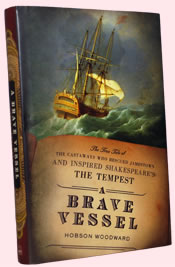The Tempest behind The Tempest:
How Shakespeare Turned Fact into Fantasy
 A Brave Vessel: The True Tale of the Castaways Who Rescued Jamestown and Inspired Shakespeare's The Tempest
A Brave Vessel: The True Tale of the Castaways Who Rescued Jamestown and Inspired Shakespeare's The Tempest
Hobson Woodward (Viking, 2009)
It is a fantastic tale. In 1609, a fleet of nine ships en route for Britain's colony at Jamestown, Va., sailed into a hurricane during which two of the vessels were lost. One of those ships was the fleet's flagship, Sea Venture, carrying Virginia's new governor, Thomas Gates, and commanded by the fleet's admiral, George Somers. The remainder of the fleet regrouped and made it to Jamestown. Almost one year later, two boats sailed into Jamestown carrying all but about a half dozen of the Sea Venture's original 153 passengers; they had survived as castaways on what Europeans long considered a devil island, Bermuda.
If Hollywood had been around in 1610, producers would be lining up to snatch the rights to the story of Gates and Somers, and the rest of the crew and passengers aboard the Sea Venture. The man who kept a diary and wrote the journey's official account, William Strachey, would at least serve as consultant on the script. This being London in 1610, however, William Shakespeare would fuse this fantastic but true tale into an even more fantastical fiction of his own concoction and steal Strachey's words in the writing of it.
With A Brave Vessel; The True Tale of the Castaways Who Rescued Jamestown and Inspired Shakespeare's The Tempest, American historian Hobson Woodward recounts the Sea Venture's adventures and details how Shakespeare incorporated elements of Strachey's account, as well as verbal passages, into his last play of sole authorship. Scholars have long accepted the connection between The Tempest and Strachey's writings, troubled only by the fact that Strachey's letters were not published until after The Tempest hit the stage (indicating Shakespeare saw them in manuscript). Woodson focuses his spotlight on Strachey, giving us a biography of the gentry-class aspirant to literary fame who unwittingly contributed to a lasting masterpiece. Along the way, relying on original documents concerning the Sea Venture's voyage as well as life in Jacobean England and colonial America, Woodward provides a fascinating, detailed depiction of Shakespeare's theater, the Jamestown colony, the Sea Venture surviving the hurricane, and its passengers' sojourn on Bermuda.
Shakespeare probably knew Strachey. Strachey rented an apartment in the Blackfriars district, as did Shakespeare, and was a shareholder in the Children of the Revels, the original company to operate in the Blackfriars playhouse. He also contributed an introductory sonnet for the play Sejanus: His Fall by Shakespeare's best bud Ben Jonson. Strachey longed to pursue a career as a writer and was a close friend of John Donne, and through him hoped to land a patronage or at least some writing gigs. Growing increasingly poor, he heeded the promise of profits offered by the Virginia Company for those who joined the Jamestown colony. Strachey saw an opportunity to write a travelogue about the New World—then all the rage in London—and thus he ended up on the Sea Venture. Gates noticed Strachey's writing skills and made him his secretary. As such, Strachey wrote the official account of both the Sea Venture's voyage and events in Jamestown for the Virginia Company, but he also wrote a letter to an "Excellent Lady," whom Woodward shows was probably Lucy, Countess of Bedford, who had been Donne's patron and was a stakeholder in the Virginia Company. It was this letter that inspired Shakespeare.
The opening chapters establishing Strachey's background provide plenty of curiosities for Shakespeare fans to appreciate, but Woodward's book turns into adventure literature in its own right when the hurricane besets the Sea Venture. Reading Woodward's account is like watching a Spielberg movie, as Somers skillfully guides his ship through the storm, and passengers and crew valiantly bail water for three days to keep from sinking. When Somers sights land, his dread really takes hold. He knows it's Bermuda with its extensive shoals that had wrecked many a ship. Renaissance sailors considered Bermuda an archipelago to be avoided, inhabited only by devils and pigs. With his crew and passengers weary and his boat still taking on water, Somers had no choice but to land there, and Woodward details the amazingly good fortune with which the Sea Venture and its apprehensive crew pass through the shoals and reach safe harbor.
The chapters covering life on the Bermudas is part Jules Verne novel, part Gilligan's Island. The castaways build a village, engage in crimes and punishments and marriages and childbirths, and build two pinnaces to carry them on to Jamestown. They also encounter strange flora and fauna, and they find sufficient food to sustain them, such as giant sea turtles, birds that the castaways called "cahows" for their call, palmetto berries, and the fruits of a cactus plant growing in the rocks, in addition to the wild (but oblivious) pigs resident on the island. Palmetto sap and cedar berries were brewed into alcoholic spirits. Pay close attention to the details of this narrative; you'll spot not only Calaban (in a variety of forms) and Ariel, but also Gonzalo, Ferdinand, Stephano, and Miranda and some of the wonders they encounter on Prospero's island.
This tale of adventure does not end when the castaways finally leave Bermuda after 10 months. For those of us who know Jamestown only as the 1607 date we had to memorize in school, the chapters detailing Strachey's 18 months there are enlightening in their detailed picture of the colony in the years after its founding. Ironically, the castaways fared far better than had the voyagers on the rest of the fleet, as the colonists endured a winter known as "the starving time" when they resorted to cannibalism (evidence of which was only recently confirmed by archaeologists after Woodward published A Brave Vessel). The Bermuda-built boats with their stores of pork, turtle, eggs, and plants were a bounty undreamed of for Jamestown's skeletal residents. As with Strachey's reporting of life in Bermuda, some of his accounts of the landscape and characters of Virginia echo in Shakespeare's Tempest.
Strachey's letter was sent on the first ship bound for England. It reached London in September 1610 and started making the rounds of the city's society. That Shakespeare might have seen it is understandable, not only because his circle of friends overlapped with that of Strachey's, but also because Shakespeare, being a familiar in King James' court, would likely have known some of the officials in the Virginia Company. However, Woodward shows that the Virginia Company had grown upset with poets on London's stages denigrating the Jamestown venture and probably would not have loaned Shakespeare the letter; rather, Woodward believes Shakespeare got hold of Strachey's writings through the printer William Welby.
Woodward has accomplished what appears to be exhaustive research for this book, but he does present some scenes as certainties where he's actually relying as much on speculation as scholarship. Foregoing full disclosures in his text does makes for better story-telling, and if you want to delve into the scholastic debates you can find all that in his extensive endnotes, some of which are as fascinating to read as the book itself.
Furthermore, this speculative approach results in a great payoff when Woodward, building on probable assumption, portrays Strachey finally returning to London and attending a performance of what was an established hit, The Tempest, at the Blackfriars. We, then, watch Shakespeare's play unfold through the eyes of Strachey, and through this device Woodward links characters, plot, descriptions, imagery, and lines themselves to Strachey's own experiences and writing. Even if you paid close attention while reading the chapters on the hurricane, Bermuda, and Jamestown, you will likely find yourself surprised at some of the parallels. You'll even see some of Strachey's class consciousness creep into Shakespeare's narrative (though Shakespeare gives it dubious regard).
As a historian, Woodward is most concerned with the story of Strachey and the Sea Venture. What little Shakespearean scholarship he employs is in service to Strachey's story. As such, many of these parallels may or may not be defensible. So, do not read A Brave Vessel as a definitive analysis of The Tempest. However, as it is generally accepted that Shakespeare was inspired by the Sea Venture's Bermuda sojourn and that he drew on Strachey's writings in the composition of the play, Woodward's 204-page tome (plus 34 pages of notes) is the story behind The Tempest's story, and is in itself a yarn worth the telling.
Eric Minton
July 10, 2013
Comment: e-mail editorial@shakespeareances.com
Start a discussion in the Bardroom



 Find additional Shakespeareances
Find additional Shakespeareances